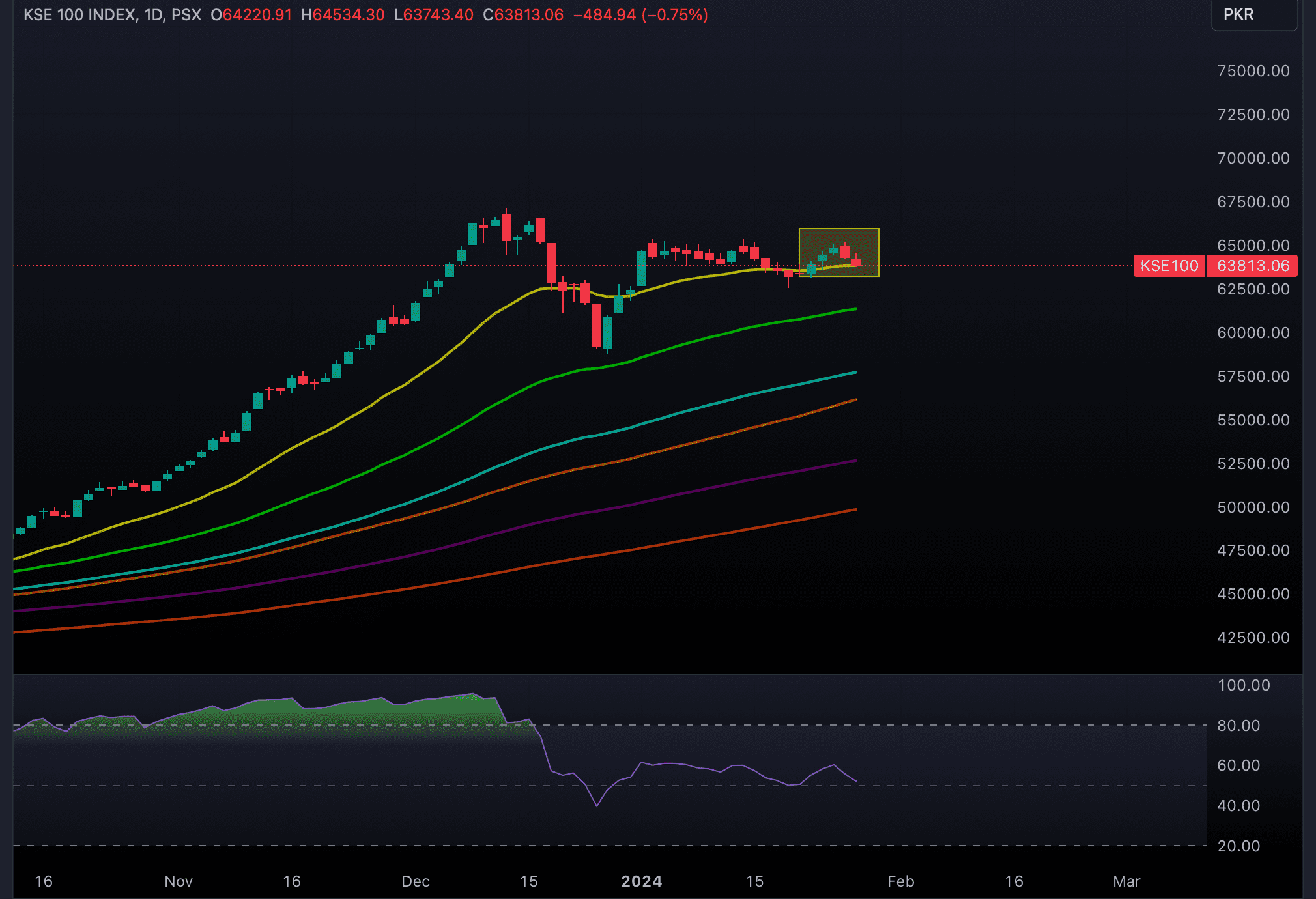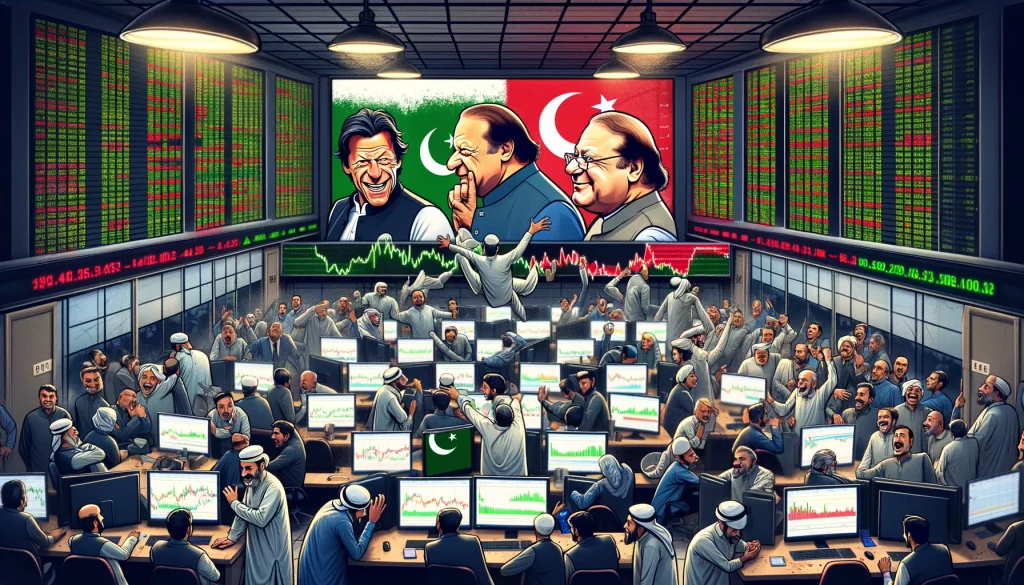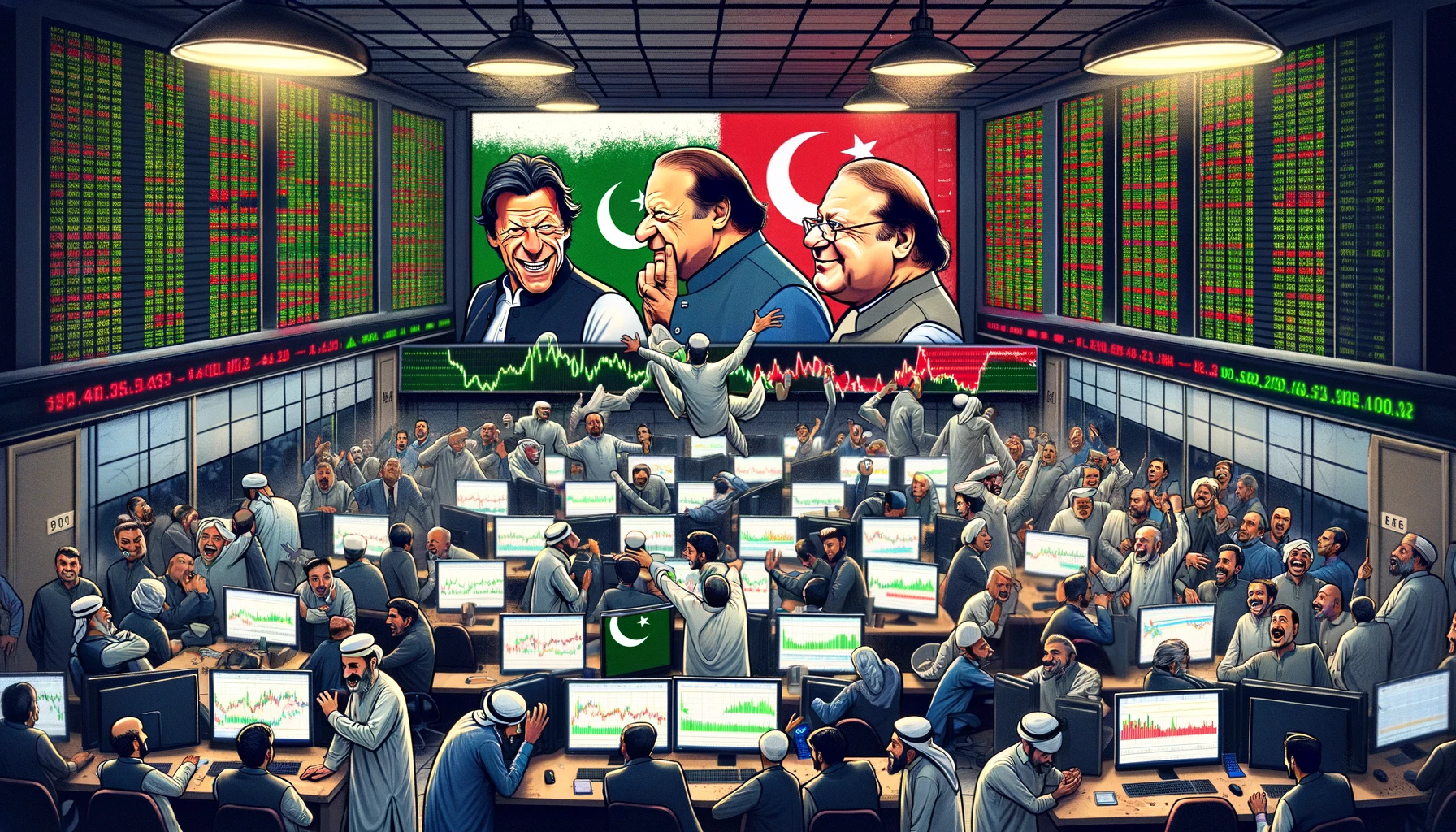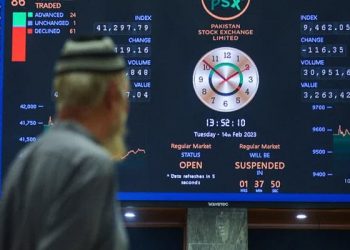OVERVIEW OF THE KSE-100 INDEX
The KSE-100 index, a bellwether of Pakistan Stock Exchange (PSX), concluded this week on a triumphant note, landing at 63,813, a notable ascent of 531 points or an increase of 0.84%. This upward trajectory reflects a vibrant and responsive market environment.

KEY TECHNICAL INDICATORS
- Relative Strength Index (RSI): The RSI stands at 36.581, which is in the ‘Sell’ territory. This indicates that the market could be considered somewhat oversold, but not yet at an extreme level.
- Stochastic Oscillator: The Stochastic value is at 98.574, indicate an ‘Overbought’ condition. This suggests that the market might be due for another correction.
- MACD (Moving Average Convergence Divergence): The MACD is at -72.72, signaling a ‘Sell’. This points towards a bearish momentum in the market.
- ADX (Average Directional Index): With an ADX value of 54.722, it also indicates a ‘Sell’. This value represents a strong directional trend, which is currently negative.
- CCI (Commodity Channel Index): The CCI is at -131.3449, which is in the ‘Sell’ zone, suggesting a potential downward price movement.
MOVING AVERAGES
The moving averages indicate a “Strong Sell” with 10 of the 12 indicators pointing to a “Sell” position. The index has been falling over a variety of time periods, according to this strong bearish signal.
THE PAKISTANI RUPEE AND DOLLAR VALUATION
As for the Pakistani Rupee PKR, it too experienced a modest yet positive shift, edging up by 0.11% week-over-week (WOW). In terms of the US Dollar, the KSE-100 index of PSX saw a slightly more pronounced growth of 0.95% over the week.
The US Dollar (USD) shows varied trends over different time frames. The immediate (READY) exchange rate is 279.5937 PKR, gradually increasing over the 1-week to 1-year periods, peaking at 300.9160 PKR for the 1-year forecast.
The local stock market’s bullish streak can be attributed to several factors, including expected economic improvements following inflows from the IMF and friendly countries, a stabilisation of PKR, and potential reductions in interest rates.
This week, on January 26, 2024, the Pakistani rupee (PKR) recorded another significant gain of 30 paisas in value relative to the US dollar. Compared to PKR 279.9 per USD last week, the local currency improved slightly, closing at PKR 279.59.
VOLATILITY AND MARKET TURNOVER
The week was marked by substantial volatility provided by key upcoming events, with the KSE-100 index of PSX fluctuated within a 2,074 point range with three days of gains and two days of losses. It oscillated between a high of 65,214 and a low of 63,140 before finally settling at 63,813. This movement signals a dynamic market responding to various domestic and international cues including elections concern, monetary policy and the IMF of-course.
A surge in market turnover was also evident this week. The average traded volume of shares soared to 248 million, valued at a significant Rs16.97 billion. This represents an increase of 12.68% month-over-month in the number of shares and an even more impressive 67.35% jump in traded value month-over-month.
BROAD MARKET PARTICIPATION
Broadening our view, the overall average traded volume for the Pakistan Stock Exchange (PSX) (All-Share) stood at 415 million shares, worth Rs20.27 billion. This marks an increase of 6.81% in the number of shares and a 47.30% rise in traded value month-over-month, showcasing robust market participation.
SECTOR-WISE PERFORMANCE
This week’s top-performing sectors were the drivers that managed to hold the sell-off the last two days of the trading week. The Oil & Gas Exploration Companies sector emerged as the standout performer, contributing an impressive 319 points to the index. This was closely followed by Commercial Banks, Fertilizer, Cement, and Leather & Tanneries sectors, which collectively bolstered the index with significant point additions.
However, not all sectors played for this positive sentiment. Technology & Communication, Power Generation & Distribution, Miscellaneous, Automobile Assembler, and Paper & Board sectors experienced downtrend, detracting points from the index.
LEADING STOCKS OF THE WEEK
Stocks that lead PSX, OGDC, EFERT, BAHL, MEBL, and HMB shone as the week’s stars, cumulatively adding significant points to the index. Conversely, PPL, SYS, FFC, HUBC, and PSO were on the other end of the spectrum, collectively pulling points away from the index.
GOVERNMENT FINANCIAL ACTIVITIES
Pakistan’s Financial activities also played a crucial role this week. The government successfully raised about Rs566 billion from three auctions at lower yields, reflecting a market leaning towards a potential downtrend in interest rates. Notably, the 6-month KIBOR dropped to its lowest level since early March 2023.
INVESTOR BEHAVIOUR AND TRENDS
Investor behaviour also revealed interesting trends. Foreign investors withdrew a substantial $22.71 million, particularly focusing their sales in the commercial banks and fertilizer sectors. Meanwhile, on the domestic front, Insurance Companies led the buying spree with a net investment of $9.58 million, primarily targeting the Fertilizer sector.
FUTURE MARKET PREDICTIONS
Looking ahead, investors will have a keen eye on the Monetary Policy Committee meeting scheduled for next Monday and the upcoming inflation and trade figures for January. The February 08 elections are also a focal point, with historical data suggesting potential gains for the market during this period.
However, investors should approach with caution, as the market’s response to elections can be unpredictable. The KSE-100’s performance following the 2018 elections serves as a reminder of this unpredictability.
In conclusion, while the KSE-100 index’s recent performance and the upcoming elections present opportunities, investors should remain vigilant, considering the market’s historical patterns and potential economic and political changes.
A STRATEGIC LOOK AT PAKISTAN’S STOCK MARKET AHEAD OF THE ELECTIONS
As Pakistan gears up for its February 08 elections, historical trends indicate a potentially lucrative phase for the country’s stock market. According to Bloomberg’s analysis, investors who have historically purchased shares in Pakistan’s KSE-100 Index just before national elections have realized an average gain of 7% in the following month. This trend, observed over the past six elections, suggests that the election period could be a ripe time for stock market investments.
HISTORICAL GAINS AND THE KSE-100 INDEX PERFORMANCE
Looking at a broader timeline, these investments have yielded a mean advance of 19% over a three-month period. These gains are in addition to the remarkable 61% increase following Pakistan’s initial agreement with the International Monetary Fund (IMF), aimed at alleviating the country’s financial challenges. Moreover, the KSE-100 has outperformed more than 90 global equity indexes since the end of June, standing as the best-performing index in dollar terms.
POLITICAL FIGURES AND THEIR INFLUENCE
Pakistan’s political landscape is dominated by key figures such as Imran Khan, the cricketer-turned-politician elected in 2018 but ousted in 2022, and his rival Nawaz Sharif, a thrice-elected prime minister who has been regaining popularity. These changes in politics have a big impact on market movements, especially since the nation’s first benchmark stock index was created in 1991.
CAUTIONARY INSIGHTS FROM PAST ELECTIONS
However, investors should always approach with caution. The post-election market response may vary, as seen in the 2018 elections where the stock index showed little change initially and then declined by over 5% in three months. The 2008 elections also presented a mixed picture, with modest gains followed by a downturn. Additionally, various analysts warn of potential seasonal trends, noting that Pakistan’s stocks have historically shown limited gains in February.
WHY THE OPTIMISM?
Despite these cautionary tales, there is optimism. The upcoming elections are anticipated to mitigate the political volatility that has been prevalent since Khan’s ouster. Sharif’s Pakistan Muslim League party is reputed for better economic management, as per a Bloomberg Intelligence report. Recent opinion polls also show a significant surge in Sharif’s popularity, which could signal a positive turn for the economy.
In summary, while the run-up to Pakistan’s elections presents an exciting opportunity for investors, it’s essential to consider the historical volatility and current political dynamics before making investment decisions as the KSE-100 index faces resistance technically.
Our content is intended to be used and must be used for informational purposes only. It is very important to do your own analysis before making any investment based on your own personal circumstances.




















